What Can Trigger Morton’s Neuroma?
 There is a nerve called the plantar digital nerve which is located between the toes. Morton’s neuroma is a condition that occurs when that nerve is irritated or squeezed and can happen from wearing shoes that do not have enough room in the toe area. When this nerve is inflamed the pressure is felt in the ball of the foot. The nerve can become thickened, and this ailment gradually becomes painful. Some of the symptoms that are associated with Morton’s neuroma can include the sensation of stepping on a pebble, the foot can feel numb, and the pain can travel between the third and fourth toes. This is a common condition among ballet dancers because of the style of dance they enjoy. There may also be existing medical conditions that can trigger Morton’s neuroma like hammertoe, bunions, and flat feet. If you have any of these symptoms please confer with a podiatrist who can guide you toward correct treatment options, which may include surgery for permanent removal of the nerve.
There is a nerve called the plantar digital nerve which is located between the toes. Morton’s neuroma is a condition that occurs when that nerve is irritated or squeezed and can happen from wearing shoes that do not have enough room in the toe area. When this nerve is inflamed the pressure is felt in the ball of the foot. The nerve can become thickened, and this ailment gradually becomes painful. Some of the symptoms that are associated with Morton’s neuroma can include the sensation of stepping on a pebble, the foot can feel numb, and the pain can travel between the third and fourth toes. This is a common condition among ballet dancers because of the style of dance they enjoy. There may also be existing medical conditions that can trigger Morton’s neuroma like hammertoe, bunions, and flat feet. If you have any of these symptoms please confer with a podiatrist who can guide you toward correct treatment options, which may include surgery for permanent removal of the nerve.
Morton’s neuroma is a very uncomfortable condition to live with. If you think you have Morton’s neuroma, contact one of our podiatrists of PA Foot & Ankle Associates. Our doctors will attend to all of your foot care needs and answer any of your related questions.
Morton’s Neuroma
Morton's neuroma is a painful foot condition that commonly affects the areas between the second and third or third and fourth toe, although other areas of the foot are also susceptible. Morton’s neuroma is caused by an inflamed nerve in the foot that is being squeezed and aggravated by surrounding bones.
What Increases the Chances of Having Morton’s Neuroma?
- Ill-fitting high heels or shoes that add pressure to the toe or foot
- Jogging, running or any sport that involves constant impact to the foot
- Flat feet, bunions, and any other foot deformities
Morton’s neuroma is a very treatable condition. Orthotics and shoe inserts can often be used to alleviate the pain on the forefront of the feet. In more severe cases, corticosteroids can also be prescribed. In order to figure out the best treatment for your neuroma, it’s recommended to seek the care of a podiatrist who can diagnose your condition and provide different treatment options.
If you have any questions, please feel free to contact one of our offices located in Allentown, Easton, Northampton, and Chew Street in Allentown, PA . We offer the newest diagnostic and treatment technologies for all your foot care needs.
How Footwear Affects Athlete’s Foot

Approximately 70% of individuals will develop a form of athlete’s foot at some point in their lives. Therefore, you ought to be aware of what this condition is and how it is linked to certain kinds of footwear. Athlete’s foot is primarily caused by a fungal infection that most commonly affects the outer skin of the foot around the toes. The fungus that causes athlete’s foot thrives in warm, moist, and damp environments. Individuals who walk barefoot in damp, public areas (such as locker rooms and pool sides) are more susceptible to athlete’s foot. However, your footwear also can make you more susceptible. For example, shoes that are tight fitting, especially around the toes, put you at risk of developing athlete’s foot because they essentially squeeze your toes together. This squeezing effect can make the area around the toes warm and moist, facilitating the fungal infection. Also, plastic footwear might make you more prone to developing athlete’s foot. This is because plastic is a material that warms and moistens the feet more than others, like canvas or leather. For more information about athlete’s foot and its connection to certain kinds of footwear, contact a podiatrist.
Athlete’s foot is an inconvenient condition that can be easily reduced with the proper treatment. If you have any concerns about your feet and ankles, contact one of our podiatrists from PA Foot & Ankle Associates. Our doctors will treat your foot and ankle needs.
Athlete’s Foot: The Sole Story
Athlete's foot, also known as tinea pedis, can be an extremely contagious foot infection. It is commonly contracted in public changing areas and bathrooms, dormitory style living quarters, around locker rooms and public swimming pools, or anywhere your feet often come into contact with other people.
Solutions to Combat Athlete’s Foot
- Hydrate your feet by using lotion
- Exfoliate
- Buff off nails
- Use of anti-fungal products
- Examine your feet and visit your doctor if any suspicious blisters or cuts develop
Athlete’s foot can cause many irritating symptoms such as dry and flaking skin, itching, and redness. Some more severe symptoms can include bleeding and cracked skin, intense itching and burning, and even pain when walking. In the worst cases, Athlete’s foot can cause blistering as well. Speak to your podiatrist for a better understanding of the different causes of Athlete’s foot, as well as help in determining which treatment options are best for you.
If you have any questions please feel free to contact one of our offices located in Allentown, Easton, Northampton, and Chew Street in Allentown, PA . We offer the newest diagnostic and treatment technologies for all your foot and ankle needs.
Are Bunions Affecting Your Everyday Life?
Gait Changes Caused By High Heels
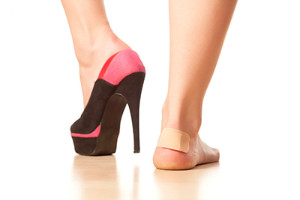
Many women wear high heels as a fashion statement and to increase their height. While these are certainly two important benefits of wearing high heels, there are also many risks. One potential risk of wearing high-heeled shoes is that it might detrimentally alter one’s gait, or walking pattern. For example, women who wear high heels sometimes exhibit shorter gait patterns and unconsciously point their toes. As a result, the gaits of these women exert more pressure on the calf muscles and can ultimately facilitate strain on the feet. Some women who wear high heels might even demonstrate these gait changes when they are not wearing high heels, such as when they are walking barefoot or in a pair of flats. Of course, sometimes wearing high heels can be an unavoidable choice. However, there are several things one might do to mitigate the extent to which high heels can change the gait. Namely, someone might limit the time that high heels are worn throughout the day and set a limit on the number of days in the week in which these shoes are worn. Contact a podiatrist for more information about how high heels can alter your gait.
High heels have a history of causing foot and ankle problems. If you have any concerns about your feet or ankles, contact one of our podiatrists from PA Foot & Ankle Associates. Our doctors can provide the care you need to keep you pain-free and on your feet.
Effects of High Heels on the Feet
High heels are popular shoes among women because of their many styles and societal appeal. Despite this, high heels can still cause many health problems if worn too frequently.
Which Parts of My Body Will Be Affected by High Heels?
- Ankle Joints
- Achilles Tendon – May shorten and stiffen with prolonged wear
- Balls of the Feet
- Knees – Heels cause the knees to bend constantly, creating stress on them
- Back – They decrease the spine’s ability to absorb shock, which may lead to back pain. The vertebrae of the lower back may compress.
What Kinds of Foot Problems Can Develop from Wearing High Heels?
- Corns
- Calluses
- Hammertoe
- Bunions
- Morton’s Neuroma
- Plantar Fasciitis
How Can I Still Wear High Heels and Maintain Foot Health?
If you want to wear high heeled shoes, make sure that you are not wearing them every day, as this will help prevent long term physical problems. Try wearing thicker heels as opposed to stilettos to distribute weight more evenly across the feet. Always make sure you are wearing the proper shoes for the right occasion, such as sneakers for exercising. If you walk to work, try carrying your heels with you and changing into them once you arrive at work. Adding inserts to your heels can help cushion your feet and absorb shock. Full foot inserts or metatarsal pads are available.
If you have any questions please feel free to contact one of our offices located in Allentown, Easton, Northampton, and Chew Street in Allentown, PA . We offer the newest diagnostic and treatment technologies for all your foot and ankle needs.
Choosing Running Shoes for Different Terrains
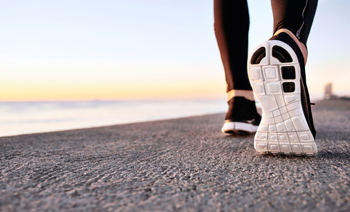
Going shoe shopping for runners can be incredibly difficult. With so many options to choose from, different brands, and different styles, selecting a running shoe can often feel daunting and impossible. However, there are certain guiding rules that you might consider keeping in mind when going shoe shopping. One guiding principle to bear in mind is that the type of running shoe that you select ought to be a good fit for the type of terrain that you are running on. For example, runners ought to consider whether they are primarily running on treadmills, tracks, streets/sidewalks, paths, or hills. Each type of terrain calls for different features in a running shoe. Namely, running on hard surfaces such as streets or sidewalks requires the running shoe to be heavily cushioned. You might look for a running shoe with hefty cushions and padding material around the heel. Running on tracks, however, requires the running shoe to have spikes so that you can grip the track and increase your speed. Lastly, if you are running on outside terrain such as a hill or an outdoor path, you could consider shopping for a running shoe that is weather resistant and significantly durable. If you are a runner in the market for a good pair of running shoes, contact a podiatrist who can help you in your search.
If you are a runner, wearing the right running shoe is essential. For more information, contact one of our podiatrists from PA Foot & Ankle Associates. Our doctors can provide the care you need to keep you pain-free and on your feet.
Choosing the Right Running Shoe for Your Foot Type
To increase performance and avoid the risk of injury, it is important to choose the right running shoe based on your foot type. The general design of running shoes revolves around pronation, which is how the ankle rolls from outside to inside when the foot strikes the ground.
- Neutral runners are able to choose from a wide variety of shoes, including minimalist shoes or even going barefoot.
- Runners who overpronate, or experience an over-abundance of ankle rolling, should choose shoes that provide extra motion control and stability.
- Runners who underpronate, or supinate, have feet that have high arches and lack flexibility, preventing shock absorption. They require shoes with more flexibility and cushion.
If you have any questions please feel free to contact one of our offices located in Allentown, Easton, Northampton, and Chew Street in Allentown, PA . We offer the newest diagnostic and treatment technologies for all your foot and ankle needs.
Types of Bone Spurs in the Heels
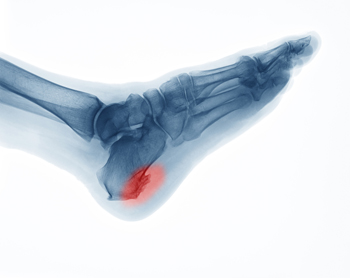
Two conditions that involve the growth of bone spurs in the heel are heel spur syndrome and insertional Achilles tendonitis. Calcaneal (heel) spurs commonly develop in people who have plantar fasciitis, an inflammation of the band of tissue that runs along the sole of the foot. Bone spurs sprout as a way of protecting the bottom of the heel. Common causes are strained foot muscles and ligaments, and over-stretching the plantar fascia. Other factors in heel spur development are age, obesity, and osteoarthritis. Fortunately, most heel spurs are not painful. Insertional Achilles tendonitis affects the part of the heel that connects to the leg bone. The spur develops around the tendon and irritates it, causing pain. The inflamed portion of the tendon can then calcify. Insertional Achilles tendonitis usually develops gradually, aided by repetitive running and jumping and the aging process. If you have heel pain, it may be a good idea to consult a podiatrist to conduct an exam and provide treatment based on the diagnosis.
Heel spurs can be incredibly painful and sometimes may make you unable to participate in physical activities. To get medical care for your heel spurs, contact one of our podiatrists from PA Foot & Ankle Associates. Our doctors will do everything possible to treat your condition.
Heels Spurs
Heel spurs are formed by calcium deposits on the back of the foot where the heel is. This can also be caused by small fragments of bone breaking off one section of the foot, attaching onto the back of the foot. Heel spurs can also be bone growth on the back of the foot and may grow in the direction of the arch of the foot.
Older individuals usually suffer from heel spurs and pain sometimes intensifies with age. One of the main condition's spurs are related to is plantar fasciitis.
Pain
The pain associated with spurs is often because of weight placed on the feet. When someone is walking, their entire weight is concentrated on the feet. Bone spurs then have the tendency to affect other bones and tissues around the foot. As the pain continues, the feet will become tender and sensitive over time.
Treatments
There are many ways to treat heel spurs. If one is suffering from heel spurs in conjunction with pain, there are several methods for healing. Medication, surgery, and herbal care are some options.
If you have any questions feel free to contact one of our offices located in Allentown, Easton, Northampton, and Chew Street in Allentown, PA . We offer the latest in diagnostic and treatment technology to meet your needs.
Are You Suffering From Ingrown Toenails?
Major Causes of Running Injuries
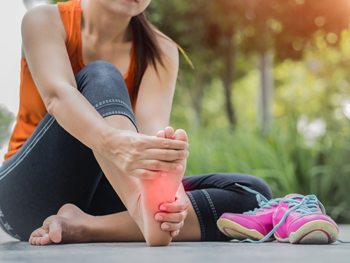
Injuries to runners are common and to be expected. It is thought that there are four main causes of injuries to runners: repetitive stress and muscle imbalance, poor running technique, poor foot strength and function, and overdoing the training. First, to help prevent muscle imbalance, experts recommend running even a third of the time on varied terrain, rather than on a treadmill, track, or other flat surface. This allows the stabilizing muscles to get involved and become stronger. Second, in terms of form, many runners over stride with a high impact technique. In addition, their shoes often have elevated heels. Instead, it is believed that forward momentum posture, keeping the arms tight to the body, landing with a bent knee, and taking more steps per minute can reduce injury. Third, proper footwear both on and off the trail is important, as is exercising the feet to build up strength. Running shoes without an elevated heel can be safer. At home, shoes that are flat, flexible, and roomy are recommended. Finally, plan ahead for a long run and train over a period of weeks, rather than pushing yourself too hard, too fast. If you frequently experience running injuries, please see a podiatrist on a regular basis for guidance on ways to run more safely.
Exercising your feet regularly with the proper foot wear is a great way to prevent injuries. If you have any concerns about your feet, contact one of our podiatrists of PA Foot & Ankle Associates. Our doctors will treat your foot and ankle needs.
How to Prevent Running Injuries
Many common running injuries are caused by overuse and overtraining. When the back of the kneecap starts wearing out and starts causing pain in your knee, this is commonly referred to as runner’s knee. Runner’s knee is a decrease in strength in your quadriceps and can occur if you’re not wearing properly fitted or supporting shoes. To prevent runner’s knee, focusing on hip strengthening is a good idea, as well as strengthening your quads to keep the kneecaps aligned.
What Are Some Causes of Running Injuries?
- One cause of a common running injury is called iliotibial band syndrome.
- Plantar fasciitis is also another common injury.
- Stress fractures can occur from overtraining, lack of calcium, or even your running style.
Best Ways to Prevent Running Injuries
- Wear footwear that fits properly and suits your running needs.
- Running shoes are the only protective gear that runners have to safeguard them from injury.
- Make a training schedule. Adding strengthening exercises as well as regular stretching can help keep you strong and limber and can lessen the possibility of injuries.
- Stretching keeps muscles limber; this will help you gain better flexibility.
If you have any questions please feel free to contact one of our offices located in Allentown, Easton, Northampton, and Chew Street in Allentown, PA . We offer the newest diagnostic and treatment technologies for all your foot and ankle needs.
How Footwear Affects Hammertoe
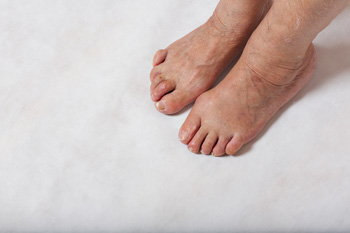
To maintain healthy, strong feet, it is imperative to be familiar with common foot conditions, their causes, and how to prevent them. One troubling foot affliction that could threaten the vitality of your feet is called hammertoe, which has a notable causal relationship with certain kinds of footwear. Hammertoe affects the second, third, or fourth toe, occurring when an imbalance in the muscles around the toe’s middle joint causes the toe to stick up at the affected joint. This causes the toe to resemble a hammer. The condition, if left untreated, can make it especially difficult or painful to walk. Importantly, your choice of footwear can impact your likelihood of developing hammertoe. For example, shoes with small toe boxes that leave little room for the toes to sit comfortably in the shoe can force the toes into tight, twisted contortions. These contortions tighten the muscles in your toes, making hammertoe more likely. Additionally, high-heeled shoes can force your toes into tight, uncomfortable positions that might also tighten your muscles in the toes. To decrease your chances of developing a hammertoe, you might choose lower-heeled shoes with spacious toe boxes. If you think you have hammertoe or want to learn more about ways to prevent this condition, reach out to a podiatrist.
Hammertoe
Hammertoes can be a painful condition to live with. For more information, contact one of our podiatrists from PA Foot & Ankle Associates. Our doctors will answer any of your foot- and ankle-related questions.
Hammertoe is a foot deformity that affects the joints of the second, third, fourth, or fifth toes of your feet. It is a painful foot condition in which these toes curl and arch up, which can often lead to pain when wearing footwear.
Symptoms
- Pain in the affected toes
- Development of corns or calluses due to friction
- Inflammation
- Redness
- Contracture of the toes
Causes
Genetics – People who are genetically predisposed to hammertoe are often more susceptible
Arthritis – Because arthritis affects the joints in your toes, further deformities stemming from arthritis can occur
Trauma – Direct trauma to the toes could potentially lead to hammertoe
Ill-fitting shoes – Undue pressure on the front of the toes from ill-fitting shoes can potentially lead to the development of hammertoe
Treatment
Orthotics – Custom made inserts can be used to help relieve pressure placed on the toes and therefore relieve some of the pain associated with it
Medications – Oral medications such as anti-inflammatories or NSAIDs could be used to treat the pain and inflammation hammertoes causes. Injections of corticosteroids are also sometimes used
Surgery – In more severe cases where the hammertoes have become more rigid, foot surgery is a potential option
If you have any questions please contact one of our offices located in Allentown, Easton, Northampton, and Chew Street in Allentown, PA . We offer the newest diagnostic and treatment technologies for all your foot and ankle needs.
Uncomfortable Athlete’s Foot
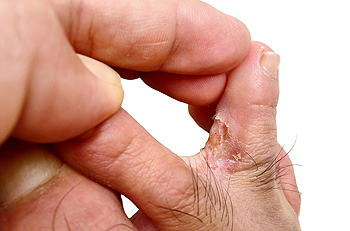
Fungus causes athlete’s foot which is contagious and can be an uncomfortable and unsightly foot condition. Many people get athlete’s foot from warm and moist environments including public swimming pools, shower room floors, and locker rooms. The fungus can enter the feet through small cracks in the skin and can produce red and itchy areas on the feet. It may be more prevalent among people who sweat profusely or those who wear shoes and socks consistently causing the feet to lack air. A common location of athlete’s foot is between the toes and on the bottom of the feet. Additional symptoms include dry, scaly skin and blisters may develop in severe cases. The toenails are often affected causing toenail fungus. The chances of full recovery can improve when this foot condition is immediately treated. If you have symptoms of athlete’s foot, it is strongly suggested that you are under the care of a podiatrist who can effectively treat this condition.
Athlete’s foot is an inconvenient condition that can be easily reduced with the proper treatment. If you have any concerns about your feet and ankles, contact one of our podiatrists from PA Foot & Ankle Associates. Our doctors will treat your foot and ankle needs.
Athlete’s Foot: The Sole Story
Athlete's foot, also known as tinea pedis, can be an extremely contagious foot infection. It is commonly contracted in public changing areas and bathrooms, dormitory style living quarters, around locker rooms and public swimming pools, or anywhere your feet often come into contact with other people.
Solutions to Combat Athlete’s Foot
- Hydrate your feet by using lotion
- Exfoliate
- Buff off nails
- Use of anti-fungal products
- Examine your feet and visit your doctor if any suspicious blisters or cuts develop
Athlete’s foot can cause many irritating symptoms such as dry and flaking skin, itching, and redness. Some more severe symptoms can include bleeding and cracked skin, intense itching and burning, and even pain when walking. In the worst cases, Athlete’s foot can cause blistering as well. Speak to your podiatrist for a better understanding of the different causes of Athlete’s foot, as well as help in determining which treatment options are best for you.
If you have any questions please feel free to contact one of our offices located in Allentown, Easton, Northampton, and Chew Street in Allentown, PA . We offer the newest diagnostic and treatment technologies for all your foot and ankle needs.
More...
Do Your Child's Feet Hurt?
How Does the Plantar Fascia Become Damaged?
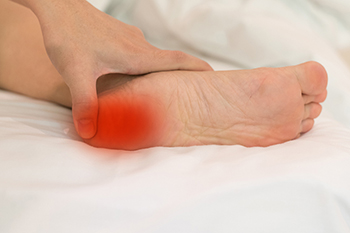
Heel pain is often associated with the condition known as plantar fasciitis. This common form of heel pain is the result of damage to, and inflammation of, the plantar fascia. The plantar fascia is the connective tissue on the sole of the foot that inserts at the heel bone, then spreads up to support the arch, and fans out to connect with each toe. Damage to the plantar fascia may be caused by wear from old age, obesity, shoes with inadequate support, and increasing physical activity too rapidly. Among the other causes are training on hard surfaces, standing for prolonged periods of time, and having flat feet or high arches. Plantar fasciitis typically causes pain in the inner/center part of the heel that worsens after periods of rest. Your podiatrist can offer various treatments to repair the plantar fascia, while reducing inflammation and pain. It is suggested that you contact one to seek treatment, as this condition may become chronic if the tissue does not heal properly.
Plantar fasciitis is a common foot condition that is often caused by a strain injury. If you are experiencing heel pain or symptoms of plantar fasciitis, contact one of our podiatrists from PA Foot & Ankle Associates. Our doctors can provide the care you need to keep you pain-free and on your feet.
What Is Plantar Fasciitis?
Plantar fasciitis is one of the most common causes of heel pain. The plantar fascia is a ligament that connects your heel to the front of your foot. When this ligament becomes inflamed, plantar fasciitis is the result. If you have plantar fasciitis you will have a stabbing pain that usually occurs with your first steps in the morning. As the day progresses and you walk around more, this pain will start to disappear, but it will return after long periods of standing or sitting.
What Causes Plantar Fasciitis?
- Excessive running
- Having high arches in your feet
- Other foot issues such as flat feet
- Pregnancy (due to the sudden weight gain)
- Being on your feet very often
There are some risk factors that may make you more likely to develop plantar fasciitis compared to others. The condition most commonly affects adults between the ages of 40 and 60. It also tends to affect people who are obese because the extra pounds result in extra stress being placed on the plantar fascia.
Prevention
- Take good care of your feet – Wear shoes that have good arch support and heel cushioning.
- Maintain a healthy weight
- If you are a runner, alternate running with other sports that won’t cause heel pain
There are a variety of treatment options available for plantar fasciitis along with the pain that accompanies it. Additionally, physical therapy is a very important component in the treatment process. It is important that you meet with your podiatrist to determine which treatment option is best for you.
If you have any questions, please feel free to contact one of our offices located in Allentown, Easton, Northampton, and Chew Street in Allentown, PA . We offer the newest diagnostic and treatment technologies for all your foot care needs.
Causes of Foot Pain
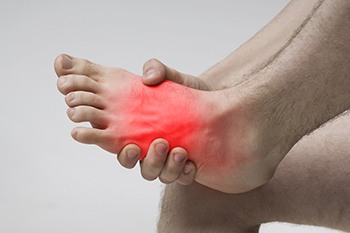
It is believed that 75 percent of people will at some point experience foot pain. This should not come as a surprise, since we are on our feet numerous times daily for nearly our entire lives. The main cause of most foot pain starts with wearing shoes that do not fit properly, are tied too tightly, have heels that are too high, or squeeze the toes. Even exercising in shoes not appropriate for the activity can cause pain in your feet as well as legs, hips, and back. Long term effects include bunions, blisters, corns, and calluses. The next likely cause of foot pain is the way you walk. Rolling your feet inward or outward when you walk can be the cause of other problems, such as flat feet, arch pain, and heel pain. Certain medical conditions, such as gout and arthritis can cause painful inflammation of the bones, ligaments, and tendons of the feet. And since the feet have 26 bones, 33 joints, and more than 100 ligaments, this can be a problem. Finally, running on hard surfaces for long periods of time can cause stress fractures and other foot injuries. A podiatrist is an expert on dealing with the many causes and treatment of foot pain. Whether your pain is immediate or ongoing, it is a good idea to consult with a podiatrist.
Foot Pain
Foot pain can be extremely painful and debilitating. If you have a foot pain, consult with one of our podiatrists from PA Foot & Ankle Associates. Our doctors will assess your condition and provide you with quality foot and ankle treatment.
Causes
Foot pain is a very broad condition that could be caused by one or more ailments. The most common include:
- Bunions
- Hammertoes
- Plantar Fasciitis
- Bone Spurs
- Corns
- Tarsal Tunnel Syndrome
- Ingrown Toenails
- Arthritis (such as Gout, Rheumatoid, and Osteoarthritis)
- Flat Feet
- Injury (from stress fractures, broken toe, foot, ankle, Achilles tendon ruptures, and sprains)
- And more
Diagnosis
To figure out the cause of foot pain, podiatrists utilize several different methods. This can range from simple visual inspections and sensation tests to X-rays and MRI scans. Prior medical history, family medical history, and any recent physical traumatic events will all be taken into consideration for a proper diagnosis.
Treatment
Treatment depends upon the cause of the foot pain. Whether it is resting, staying off the foot, or having surgery; podiatrists have a number of treatment options available for foot pain.
If you have any questions, please feel free to contact one of our offices located in Allentown, Easton, Northampton, and Chew Street in Allentown, PA . We offer the newest diagnostic and treatment technologies for all your foot care needs.
Wearing Orthotics May Help Heel Spurs
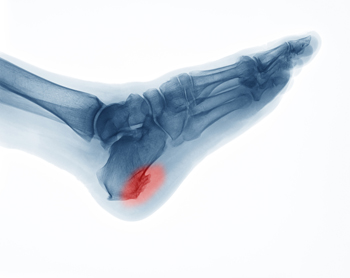
A bony growth that forms on the back of the heel bone is known as a heel spur. It can gradually produce severe pain and discomfort, and it may become difficult to walk. A heel spur can develop for several reasons, including wearing shoes that do not fit correctly, exercising on hard surfaces, or standing for long periods. A common symptom that many people experience is a sharp pain in the bottom of the heel, and this may diminish while walking. After a proper diagnosis is performed, correct treatment can begin. It may be beneficial to practice specific stretches that can help to ease the pain of a heel spur. An effective stretch consists of standing on a step and lowering the heel until a gentle pull is felt. Some patients find it can help to wear custom-made orthotics that can control the excess motion that affects the bottom of the foot. Additionally, orthotics can help take the pressure off of a heel spur. If you are affected by this painful foot condition, please consult with a podiatrist who can determine what the best form of treatment is for you.
Heel spurs can be incredibly painful and sometimes may make you unable to participate in physical activities. To get medical care for your heel spurs, contact one of our podiatrists from PA Foot & Ankle Associates. Our doctors will do everything possible to treat your condition.
Heels Spurs
Heel spurs are formed by calcium deposits on the back of the foot where the heel is. This can also be caused by small fragments of bone breaking off one section of the foot, attaching onto the back of the foot. Heel spurs can also be bone growth on the back of the foot and may grow in the direction of the arch of the foot.
Older individuals usually suffer from heel spurs and pain sometimes intensifies with age. One of the main condition's spurs are related to is plantar fasciitis.
Pain
The pain associated with spurs is often because of weight placed on the feet. When someone is walking, their entire weight is concentrated on the feet. Bone spurs then have the tendency to affect other bones and tissues around the foot. As the pain continues, the feet will become tender and sensitive over time.
Treatments
There are many ways to treat heel spurs. If one is suffering from heel spurs in conjunction with pain, there are several methods for healing. Medication, surgery, and herbal care are some options.
If you have any questions feel free to contact one of our offices located in Allentown, Easton, Northampton, and Chew Street in Allentown, PA . We offer the latest in diagnostic and treatment technology to meet your needs.



